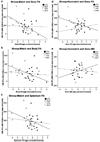Callosal Compromise Differentially Affects Conflict Processing and Attentional Allocation in Alcoholism, HIV, and Their Comorbidity
- PMID: 19360136
- PMCID: PMC2666876
- DOI: 10.1007/s11682-007-9014-z
Callosal Compromise Differentially Affects Conflict Processing and Attentional Allocation in Alcoholism, HIV, and Their Comorbidity
Abstract
Diffusion tensor imaging was used to study the combined effects of HIV-infection and alcoholism (ALC) on corpus callosum (CC) integrity in relation to processes of attentional allocation and conflict resolution assessed by a novel Stroop Match-to-Sample task. We tested 16 ALC, 19 HIV, 20 subjects with combined disorder and 17 controls. In ALC, low fractional anisotropy and high mean diffusivity throughout the CC correlated with poor Stroop-match performance, i.e., when the cue-color matched the color of the Stroop stimulus. By contrast, in the two HIV groups DTI relations were restricted to the genu and poor Stroop-nonmatch performance, i.e., when the cue-color was in conflict with the Stroop stimulus color. These results suggest that disruption of callosal integrity in HIV-infection and alcoholism differentially affects regionally-selective interhemispheric-dependent attentional processing. We speculate that callosal degradation in these diseases curtails the opportunity for collaboration between the two hemispheres that contributes to normal performance in HIV or alcoholic patients with higher callosal integrity.
Figures




Similar articles
-
White matter fiber compromise contributes differentially to attention and emotion processing impairment in alcoholism, HIV-infection, and their comorbidity.Neuropsychologia. 2012 Oct;50(12):2812-2822. doi: 10.1016/j.neuropsychologia.2012.07.042. Epub 2012 Aug 7. Neuropsychologia. 2012. PMID: 22960416 Free PMC article.
-
Differential effect of HIV infection and alcoholism on conflict processing, attentional allocation, and perceptual load: evidence from a Stroop Match-to-Sample task.Biol Psychiatry. 2005 Jan 1;57(1):67-75. doi: 10.1016/j.biopsych.2004.09.025. Biol Psychiatry. 2005. PMID: 15607302
-
Disruption of emotion and conflict processing in HIV infection with and without alcoholism comorbidity.J Int Neuropsychol Soc. 2011 May;17(3):537-50. doi: 10.1017/S1355617711000348. J Int Neuropsychol Soc. 2011. PMID: 21418720 Free PMC article.
-
Altered white matter integrity in the corpus callosum in adults with HIV: a systematic review of diffusion tensor imaging studies.Psychiatry Res Neuroimaging. 2022 Oct;326:111543. doi: 10.1016/j.pscychresns.2022.111543. Epub 2022 Sep 9. Psychiatry Res Neuroimaging. 2022. PMID: 36126346 Review.
-
The role of diffusion tensor imaging and fractional anisotropy in the evaluation of patients with idiopathic normal pressure hydrocephalus: a literature review.Neurosurg Focus. 2016 Sep;41(3):E12. doi: 10.3171/2016.6.FOCUS16192. Neurosurg Focus. 2016. PMID: 27581308 Review.
Cited by
-
Transcallosal white matter degradation detected with quantitative fiber tracking in alcoholic men and women: selective relations to dissociable functions.Alcohol Clin Exp Res. 2010 Jul;34(7):1201-11. doi: 10.1111/j.1530-0277.2010.01197.x. Epub 2010 May 7. Alcohol Clin Exp Res. 2010. PMID: 20477772 Free PMC article.
-
Task-rest modulation of basal ganglia connectivity in mild to moderate Parkinson's disease.Brain Imaging Behav. 2015 Sep;9(3):619-38. doi: 10.1007/s11682-014-9317-9. Brain Imaging Behav. 2015. PMID: 25280970 Free PMC article.
-
Age-related reorganization of functional networks for successful conflict resolution: a combined functional and structural MRI study.Neurobiol Aging. 2011 Nov;32(11):2075-90. doi: 10.1016/j.neurobiolaging.2009.12.002. Epub 2009 Dec 22. Neurobiol Aging. 2011. PMID: 20022675 Free PMC article.
-
Neurodevelopmental disorders: 2021 update.Free Neuropathol. 2021 Mar 24;2:6. doi: 10.17879/freeneuropathology-2021-3268. eCollection 2021 Jan. Free Neuropathol. 2021. PMID: 37284629 Free PMC article.
-
Callosal degradation in HIV-1 infection predicts hierarchical perception: a DTI study.Neuropsychologia. 2010 Mar;48(4):1133-43. doi: 10.1016/j.neuropsychologia.2009.12.015. Epub 2009 Dec 16. Neuropsychologia. 2010. PMID: 20018201 Free PMC article.
References
-
- American Psychiatric Association. Diagnostic and statistical manual of mental disorders. 4th ed. Washington, DC: American Psychiatric Press; 1994.
-
- Basser PJ, Pierpaoli C. Microstructural and physiological features of tissues elucidated by quantitative-diffusion-tensor MRI. Journal of Magnetic Resonance. Series B. 1996;111:209–219. - PubMed
-
- Brailoiu E, Brailoiu GC, Mameli G, Dolei A, Sawaya BE, Dun NJ. Acute exposure to ethanol potentiates human immunodeficiency virus type 1 Tat-induced Ca(2+) overload and neuronal death in cultured rat cortical neurons. Journal of Neurovirology. 2006;12:17–24. - PubMed
-
- Bush G, Shin LM, Holmes J, Rosen BR, Vogt BA. The multi-source interference task: Validation study with fMRI in individual subjects. Molecular Psychiatry. 2003;8:60–70. - PubMed
-
- Carter CS, Botvinick MM, Cohen JD. The contribution of the anterior cingulate cortex to executive processes in cognition. Reviews in the Neurosciences. 1999;10:49–57. - PubMed
Grants and funding
LinkOut - more resources
Full Text Sources
